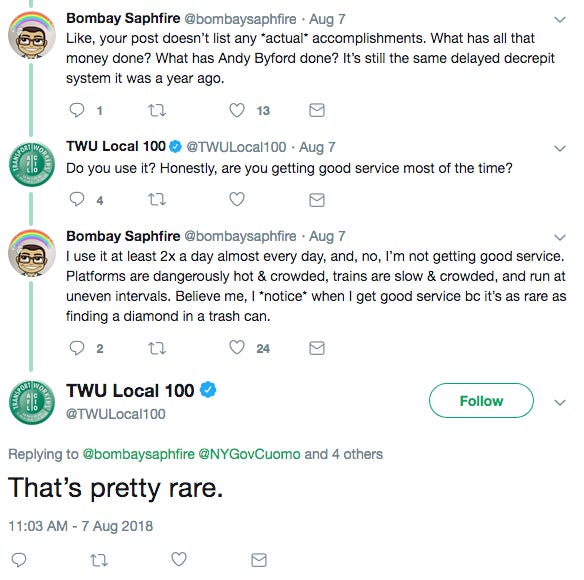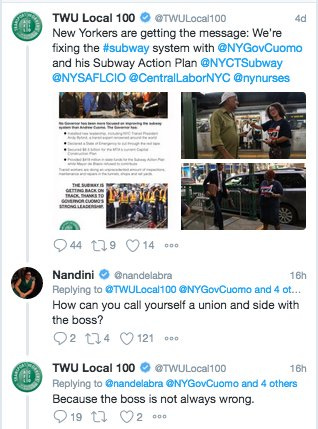August 17, 2018: Totes
Hi, Signal Problems readers. I want to spend as little time on this as possible so we can get back to transit news, so let me get right to it: I’m starting a fundraising drive to help keep Signal Problems afloat. Any amount is greatly appreciated, but if you give $25 or more, you’ll get this limited edition tote bag with original Signal Problems-themed art.

Why am I asking you to contribute? I’ve been writing Signal Problems for more than eight months now. On average, I spend around 10 hours per week researching, writing, and editing Signal Problems, and some more on top of that responding to reader questions (which I consider part of running the newsletter). I enjoy doing all of this, but at the end of the day I’m a freelance journalist trying to make ends meet.
This conundrum is something I’ve been thinking about for many months without settling on an obvious solution. I don’t want to charge for more content just for more content’s sake. But one day I was sitting on a crowded subway and had someone’s tote sticking in my face. And that’s when I got the idea for the S/P tote.
To me, the tote has a special place in S/P’s genesis as the main carrier for dogs in bags. The idea made natural sense to me in a way that none of the others did. I commissioned Adam Fisher-Cox, who longtime readers may remember as the man behind the countdown clock and Airtrain redesigns, to make some art for a limited edition S/P tote.
“When Aaron presented the idea of an illustration of a dog in a bag, I knew I wanted to recreate the feeling of seeing one on the train or platform,” Fisher-Cox says about how he came up with this design. “For a second the oppressive heat, weird smells, and people shoving past each other disappear and you get to enjoy the image of a little face in a bag who happily has no idea where he is or where he's going. The weekly photos of dogs in bags in the Signal Problems newsletter serve as a similar palette cleanser after a series of reliably negative reminders of the subway's state of affairs, so it made complete sense to run with this familiar scene.”
So, why should you give to Signal Problems? Here are a few possible reasons:
You enjoy Signal Problems
You’d like to continue reading Signal Problems in the future
You want to support my work, both at Signal Problems and elsewhere, in an increasingly challenging local media environment
You’d like a tote bag
If any of these sound worthwhile to you, click here.
As always, send thoughts, comments, feedback, and Dog in a Bag photos to aaron.wittes.gordon@gmail.com. And thanks, as always, for reading.
On Tuesday, the WSJ reported that the MTA is cutting Select Bus Service expansion, bus fare enforcement on local routes, and some subway cleaners in order to save a few bucks to pay for the Subway Action Plan. One way to interpret this news, as the WSJ did, is that these are effectively service cuts. Or, as one board member noted in emails leaked to the WSJ, “It’s hard to escape the conclusion that we’ve giveth with one hand through the Subway Action Plan, and we’ve taketh away, to some extent, through these service cuts.”
But that’s not my read on the situation. At least, not entirely. Two of the three planned cuts can be justified, even hailed, as good policy.
For the SBS halt, NYCT is undertaking a multi-year redesign of the city’s entire bus network by 2021, which will include not only better routes with fewer stops but (hopefully) all-door payment with the new fare payment technology to be implemented starting next year. These are two of the very improvements that made SBS successful along with dedicated lanes—which have been known on rare occasions to actually be empty of other vehicles—and transit signal priority (TSP), giving buses green lights as often as possible. The goal should not be to expand SBS, but to, as TransitCenter’s Jon Orcutt told Streetsblog, “SBS-ize the whole system.”
Given NYCT says they’re overhauling bus service in the next three years, rolling out a few SBS routes in the interim doesn’t make much sense. (In fact, it’s easy to imagine an alternate scenario where NYCT went full speed ahead on these SBS’s just to save face but they turned out to be almost redundant by a network redesign and fleet-wide improvements.) Better to re-think the entire network from the ground up with as few constraints as possible.
As for the cuts in fare enforcement, such teams on local routes have repeatedly shown they don’t pay for themselves. If the people enforcing fare payment can’t pay for themselves, that’s an indication fare-beating either isn’t really that big of a problem or not worth the effort to curtail. Either way, it’s a sound, progressive, and practical decision to not waste time and money on it.
The subway cleaning crews are a different story. I certainly can’t justify that on its face, especially as NYCT claims to be prioritizing customer experience. That gets a big ol’ ¯\_(ツ)_/¯.
But the much bigger issue is the reported necessity of these cuts. That is, they’re to pay for the Subway Action Plan, a largely ineffective effort to “stabilize” a system that is still quite unstable.
What the Subway Action Plan has accomplished is hiring 1,100 more Transit Workers Union dues-paying members. As a result, TWU Local 100 hit the campaign trail hard for Governor Cuomo this week, handing out flyers and working those keyboards on the official Twitter account in favor of their job creator.

The point is that those 1,100 workers are being paid with money that could have gone towards other things. Now, good on the MTA for finding the money in at least a few things that make sense to cut. Lord knows there’s more where that came from. But the day may come when it will be most politically expedient to cut something that really shouldn’t be. Maybe it’s the subway cleaners. Maybe it’s a real service cut. Maybe it’s more.
Up until now, the Subway Action Plan was mostly harmless, a very expensive plan to placate necessary parties so we could start talking about real fixes. But now, my concern is not only was it a very expensive make-work program, but in order to pay for it, the MTA may have to cut something actually worthwhile. Here’s to hoping it doesn’t come to that.
News You Probably Can't Use, But About Which You Can Certainly Brood
I wrote about hot subway cars last week, but what can be done about hot subway platforms? Not much in the short term, say the people I talked to for my latest Village Voice article. And to do anything about it in the long term would require money and prioritization, so it’ll have to contend with all the other stuff that needs money and prioritization.
The latest S&P downgrade of the MTA’s credit rating portends bad things. In short, the MTA has already borrowed some $40 billion and needs a new revenue stream just to keep itself afloat, much less another $19 billion to actually fix stuff.
Twitter thread from Newsday’s Albany reporter, Michael Gormley: “ICYMI: Among Cuomo's fundraising was an event last month at a food service company at LaGuardia Airport, site of an $8B state overhaul. That day Cuomo’s campaign collected more than $85k from four donors, in addition to other contributions. Since 2011, the company has contributed $145k to Cuomo’s campaigns. In 2015, top Cuomo aide Larry Schwartz took a job with OTG.”
That would, of course, be the same Larry Schwartz that Cuomo appointed to the MTA board, and the same Larry Schwartz who rudely lambasted a Reinvent Albany analyst speaking at a Board meeting about good governance practices. "Do not start accusing [Lhota] or anyone else on this board of pay-to-play or conflicts of interest, especially when you don't know your facts and your facts are totally wrong,” Schwartz warned.AM New York’s Vin Barone profiled NYCT’s new accessibility chief, Alex Elegudin, and the ginormous task he has ahead of him.
The Voice ran a retrospective on a 1977 article titled “WHY WE HATE THE SUBWAYS” which features this remarkable bit by Alexander Cockburn after taking an hour to get from 96th St to Union Square: “By now I am very highly motivated. I will work very hard so that I can make enough money to always travel by taxi, and so that I can pay for a good lawyer to defend me after I have kidnapped the senior members of the MTA and murdered them by throwing them onto the third rail.”
An inside look at NYCT’s $300 million plan to prevent bus bunching.
TWU and NYCT are considering putting body cams on transit workers in response to recent assaults.
I guess ceilings crumbling is just going to be a regular feature of our transit experience now.

@NYCTSubway Spotted at City Hall station. Part of the ceiling appears to have fallen. pic.twitter.com/uA5mOYCS8L
August 15, 2018If you’re not registered to vote, you’ve only got a few more days to do so if you want to vote in the primaries.
In Which I Make An Educated Guess About When Things Will Get Better
This week's estimate: June 2022
Change log:
May 25, 2018: June 2022
March 30, 2018: 2030
March 16, 2018: 2024
February 2, 2018: 2021
January 20, 2018: 2020
Your Upcoming Service Advisories, Provided by Lance from Subway Weekender
Note: the service advisories reflect the most disruptive changes. Be sure to check the maps or the MTA website for a full list of service changes.
Weekend:
2 – No service between E 180 Street and 135 Street
5 – No service between E 180 Street and 149 St-Grand Concourse
7 – Manhattan-bound service is express-only in Queens
A C – Uptown service is express-only between 59 St-Columbus Circle and 125 Street
D – multiple diversions
No service between 34 St-Herald Sq and Atlantic Av-Barclays Center
All service is express-only in Brooklyn
F – Brooklyn-bound service runs via E and C lines between Roosevelt Av and Jay St
G – No service
J – No service between Crescent St and Jamaica Center
L – Service is split at Broadway Junction
N Q – Manhattan-bound service runs via R line between Atlantic Av and Canal St
Late Nights:
2 – No service between 3 Av-149 St and 96 Street
3 – No service
D – multiple diversions
No service between 34 St-Herald Sq and Atlantic Av-Barclays Center
All service is express-only in Brooklyn
F – All service is local in Queens
Q – Manhattan-bound service runs via R line between DeKalb Av and Canal St
Meanwhile, in the Rest of the World
This list of “some things that happen whenever a big bus network redesign is first proposed to the public,” put together by the guy who just redesigned the Dublin bus network will be good to keep in mind as NYCT endeavors to redesign the entire city bus network.
Speaking of bus redesigns, here’s some reason for optimism as the Staten Island redesigned network goes into effect next week: Columbus, Ohio is seeing a 3.6 percent increase in ridership after redesigning its network for the first time in 40 years. Part of that redesign included doubling the number of routes with a service frequency of 15 minutes or better.
San Francisco just opened the Salesforce Transit Center, which for now is the world’s most expensive bus station (it will, hopefully, have trains some time in the future).
Provo, Utah is unwrapping its new Bus Rapid Transit line. When completed, more than half the route will have a bus-only lane. Fares will be free for three years thanks to a federal grant.
Malaysia is cutting its light rail plan by roughly 50 percent to save costs. They cut their rail car order in half, won’t build several stations, and somehow determined they don’t need a 1.2 mile tunnel after all. They’re also delaying completion by four years. Sounds like a mess, but at least they’ll save taxpayers $3.5 billion.
In a just world, Elon Musk would be laughed out of any city with his Hyperloop proposals. Instead, the Mayor of LA praised his harebrained scheme to build one to Dodger Stadium. Transit expert Yonah Freemark did the math on such a project’s capacity/revenue projections, and found the 3.6-mile tunnel (not to mention the stations and whatever vehicles they choose to use that totally, totally aren’t buses) would have to be built for $23 million.
David Roth’s Esteemed Subway Rider of the Week
“Our distinguished passenger was on the Q, on Sunday. Physically robust man in shorts, a polo shirt, some kind of vest, and a floppy hat got on, his shorts sort of droopy in a way that I will admit worried me a bit. This worry was alleviated by him removing a black leather belt from his pocket—the buckle hit the ground and made a sound—running it through the belt loops on his shorts and finally securing it and his shorts around his waist. We had a moment of eye contact when he turned around afterwards and I nodded at him and he nodded back. It's hard to know what to do in a situation like that, but I meant for my nod to communicate 'I saw what you did and I respect it very much' and I think he understood it as such.”
Dog in a Bag
MTA Rules of Conduct Section 1050.9 Subsection (h) Paragraph 2: no person may bring any animal on or into any conveyance or facility unless enclosed in a container and carried in a manner which would not annoy other passengers.
Have a dog in a bag photo? Reading this on the subway and see a dog in a bag? Take a picture and send it to aaron.wittes.gordon@gmail.com.
 Photo credit: Laurel Parrish
Photo credit: Laurel Parrish
This has been another edition of Signal Problems, a weekly newsletter helping you figure out what is going on with the subway, made every week by Aaron Gordon, freelance transportation reporter. Read on the web or view the archives at signalproblems.nyc.
If you’re enjoying this newsletter, please share it with others. It’s the best way you can say thanks.
As always, send any feedback, subway questions, or Dog in a Bag photos to aaron.wittes.gordon@gmail.com. I’d love to hear from you. As someone on a stalled Q train once told me, we’re all in this together.



